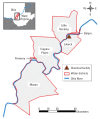Association of perfluorooctanoic acid (PFOA) and perfluorooctane sulfonate (PFOS) with uric acid among adults with elevated community exposure to PFOA
- PMID: 20123605
- PMCID: PMC2831922
- DOI: 10.1289/ehp.0900940
Association of perfluorooctanoic acid (PFOA) and perfluorooctane sulfonate (PFOS) with uric acid among adults with elevated community exposure to PFOA
Abstract
Background: Perfluorooctanoic acid (PFOA) and perfluorooctane sulfonate (PFOS) are compounds that do not occur in nature, have been widely used since World War II, and persist indefinitely in most environments. Median serum levels in the United States are 4 ng/mL for PFOA and 21 ng/mL for PFOS. PFOA has been associated with elevated uric acid in two studies of chemical workers. Uric acid is a risk factor for hypertension and possibly other cardiovascular outcomes.
Methods: We conducted a cross-sectional study of PFOA and PFOS and uric acid among 54,951 adult community residents in Ohio and West Virginia, who lived or worked in six water districts contaminated with PFOA from a chemical plant. Analyses were conducted by linear and logistic regression, adjusted for confounders.
Results: Both PFOA and PFOS were significantly associated with uric acid. An increase of 0.20.3 mg/dL uric acid was associated with an increase from the lowest to highest decile of either PFOA or PFOS. Hyperuricemia risk increased modestly with increasing PFOA; the odds ratios by quintile of PFOA were 1.00, 1.33 [95% confidence interval (CI), 1.241.43], 1.35 (95% CI, 1.261.45), 1.47 (95% CI, 1.371.58), and 1.47 (95% CI, 1.371.58; test for trend, p < 0.0001). We saw a less steep trend for PFOS. Inclusion of both correlated fluorocarbons in the model indicated PFOA was a more important predictor than was PFOS.
Conclusion: Higher serum levels of PFOA were associated with a higher prevalence of hyperuricemia, but the limitations of cross-sectional data and the possibility of noncausal mechanisms prohibit conclusions regarding causality.
Figures




Similar articles
-
Inverse association of colorectal cancer prevalence to serum levels of perfluorooctane sulfonate (PFOS) and perfluorooctanoate (PFOA) in a large Appalachian population.BMC Cancer. 2014 Jan 27;14:45. doi: 10.1186/1471-2407-14-45. BMC Cancer. 2014. PMID: 24468211 Free PMC article.
-
Association of perfluorooctanoic acid and perfluorooctane sulfonate with serum lipids among adults living near a chemical plant.Am J Epidemiol. 2009 Nov 15;170(10):1268-78. doi: 10.1093/aje/kwp279. Epub 2009 Oct 21. Am J Epidemiol. 2009. PMID: 19846564
-
Isomers of per- and polyfluoroalkyl substances and uric acid in adults: Isomers of C8 Health Project in China.Environ Int. 2019 Dec;133(Pt A):105160. doi: 10.1016/j.envint.2019.105160. Epub 2019 Sep 10. Environ Int. 2019. PMID: 31518937
-
Tenuous dose-response correlations for common disease states: case study of cholesterol and perfluorooctanoate/sulfonate (PFOA/PFOS) in the C8 Health Project.Drug Chem Toxicol. 2011 Oct;34(4):396-404. doi: 10.3109/01480545.2011.582502. Epub 2011 Jul 19. Drug Chem Toxicol. 2011. PMID: 21770727 Review.
-
Perfluoroalkyl chemicals and human fetal development: an epidemiologic review with clinical and toxicological perspectives.Reprod Toxicol. 2009 Jun;27(3-4):212-230. doi: 10.1016/j.reprotox.2009.02.001. Epub 2009 Feb 20. Reprod Toxicol. 2009. PMID: 19429401 Review.
Cited by
-
Perfluoroalkyl substances and likelihood of stroke in persons with and without diabetes.Diab Vasc Dis Res. 2020 Jan-Feb;17(1):1479164119892223. doi: 10.1177/1479164119892223. Epub 2019 Dec 16. Diab Vasc Dis Res. 2020. PMID: 31841043 Free PMC article.
-
Dynamics of associations between perfluoroalkyl substances and uric acid across the various stages of glomerular function.Environ Sci Pollut Res Int. 2019 Apr;26(12):12425-12434. doi: 10.1007/s11356-019-04666-5. Epub 2019 Mar 7. Environ Sci Pollut Res Int. 2019. PMID: 30847808
-
How to Practice Environmental Medicine.Integr Med (Encinitas). 2017 Oct;16(5):8-15. Integr Med (Encinitas). 2017. PMID: 30936798 Free PMC article.
-
The Association of Perceived Memory Loss with Osteoarthritis and Related Joint Pain in a Large Appalachian Population.Pain Med. 2018 Jul 1;19(7):1340-1356. doi: 10.1093/pm/pnx107. Pain Med. 2018. PMID: 28525629 Free PMC article.
-
Epidemiologic evidence on the health effects of perfluorooctanoic acid (PFOA).Environ Health Perspect. 2010 Aug;118(8):1100-8. doi: 10.1289/ehp.0901827. Epub 2010 Apr 27. Environ Health Perspect. 2010. PMID: 20423814 Free PMC article. Review.
References
-
- Costa G, Sartori S, Consonni D. Thirty years of medical surveillance in perfluooctanoic acid production workers. J Occup Environ Med. 2009;51(3):364–372. - PubMed
-
- Dimitroula HV, Hatzitolios AI, Karvounis HI. The role of uric acid in stroke: the issue remains unresolved. Neurologist. 2008;14(4):238–242. - PubMed
Publication types
MeSH terms
Substances
LinkOut - more resources
Full Text Sources

